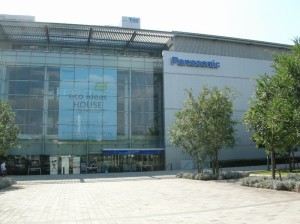Can green tech take Panasonic out of the red?


TOKYO -- Panasonic may be one of the world's best known electronics brands, but the company is also in serious financial trouble. As with other once-mighty Japanese electronics firms, including Sony, sales of Panasonic's traditional profit-makers such as TVs and cameras have plummeted in recent years, thanks to competition from other Asian countries including South Korea, plus the strong Yen. Panasonic is in the worst financial state of its almost century-long history, losing 9 billion dollars in the first three months of 2012 alone, as sales fell by ten percent. Faced with falling profits in its traditional businesses, Panasonic is in search of a new direction.
The Panasonic center, an aircraft-hangar sized showroom in a Tokyo suburb, gives the best indicaton of where the company is headed. Black-cased TVs and digital cameras are out, in favour of solar panels, fuel cells and batteries, shown against a background of ecological greens and angelic whites. Those products form the core of Panasonic's "eco-ideas" strategy, which launched in 2007. The company aims to become the "number one green innovation company in electronics industry," according to its website.
Blue-uniformed guides escort visitors around Panasonic's "eco-ideas" house, a reconstruction of a Suburban Tokyo house, which according to the company has almost no carbon-dioxide emissions. The house draws most of its energy from solar panels on its roof, and a home fuel cell which converts natural gas into electricity. Smart sensors monitor every aspect of the household's energy use, automatically switching between sunlight and LCD lighting, depending on the time of day. Smart materials such as U-Vacua, an insulation material patented by Panasonic, keep the house energy-efficient.
The house's green innovations are impressive, but high prices mean much of the technology will be a difficult sell to ordinary consumers. Take Panasonic's flagship home-fuel cell, known as the 'Ene-farm', which allows consumers to generate their own-low carbon electricity using any supply of natural gas, for example. A nearly two-meter high water tank which rises out of the eco-house's back garden like a monolith from the film 2001, captures the Ene-farms' only bi-product: hot water, and uses it to heat the house. Apart from saving on carbon emissions, it's an idea whose time has come in Japan, which is searching for ways to reduce its reliance on nuclear power following the Fukushima accident last year.
But sales of the Ene-farm have been limp so far, with Panasonic shifting just 4000 units in the first two years of the product's life, according to Panasonic. The cell's price tag is mainly to blame - the Ene-farm launched at a price of 3 million yen (around 37 thousand US dollars) per unit. Even with a government subsidy covering a third of the price, it would take an average Tokyo household well over a decade to recoup the asking price, according to statistics from Japanese firm Toho Gas.
Panasonic hopes that continued design improvements, and new partnerships with energy firms will make the Ene-farm more popular with ordinary consumers. The latest version of the Ene-farm operates at 40 percent efficiency, and takes up half the space of the previous model, Panasonic said. Production costs have fallen by 30 percent, thanks to a reduced use of expensive materials such as platinum, and a partnership with Tokyo's main gas company will ease installation for city residents. But the Ene-farm will be beyond the reach of the average Japanese household for years to come. "We're aiming for a price range that is reasonable for the general population by 2015 but that price hasn't come to any concrete figures yet," a Panasonic spokesperson said in an email to Smart Planet.
Panasonic's green efforts aren't just restricted to home fuel cells. The company is also making a big push into the solar energy market, opening a new $580 million solar cell factory in Malaysia. As with the Ene-farm, Panasonic hopes to sell solar panels to home-consumers. But the company will face stiff competition as more foreign players, including low-cost Chinese manufacturers, enter the Japanese market.
For Panasonic, "Green is the new black," Cathy Liu, Panasonic Japan's Public Relations officer, said. Getting out of loss-making TV business is clearly the right choice for the troubled firm, but whether going green is enough to drag the firm back into the black remains the key question for Panasonic's shareholders.
This post was originally published on Smartplanet.com